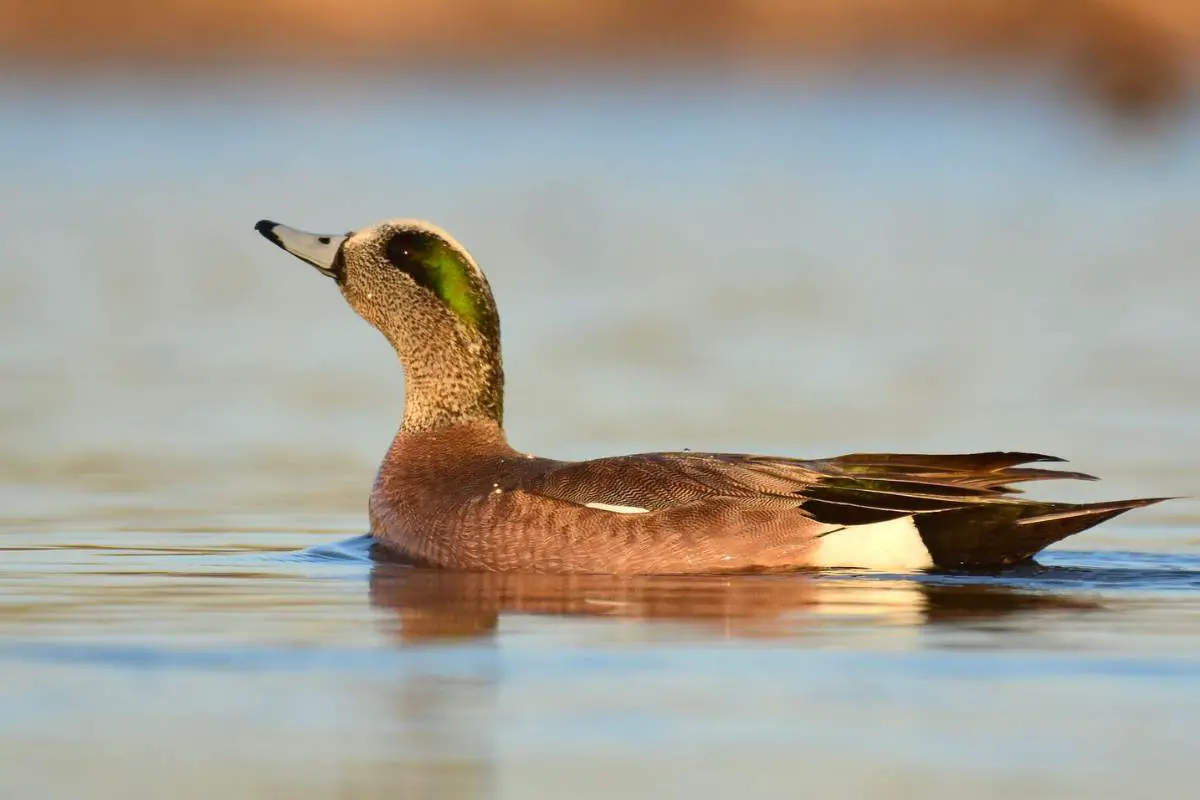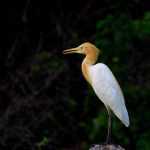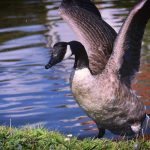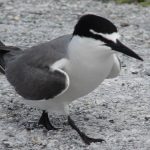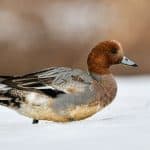Common Name: American Wigeon
Scientific Name: Mareca americana| Size | Diet | Range in Hawaii | Status in Hawaii |
|---|---|---|---|
| 18 in. - 23 in. | insects, snails, and crustaceans | Common on all Islands | Least Concern |
With its captivating colors and graceful presence, the American Wigeon (Mareca americana) stands out among the waterbirds that inhabit wetlands and coastlines. Its vibrant plumage and elegant demeanor make it a favorite among birdwatchers. While typically found in marshes, ponds, and lakes, this dabbling duck has also made its unexpected home in the tropical paradise of Hawaii.
Join us as we explore the unique features and surprising existence of the American Wigeon, a true symbol of beauty in nature’s watery realms.
American Wigeon
Appearance
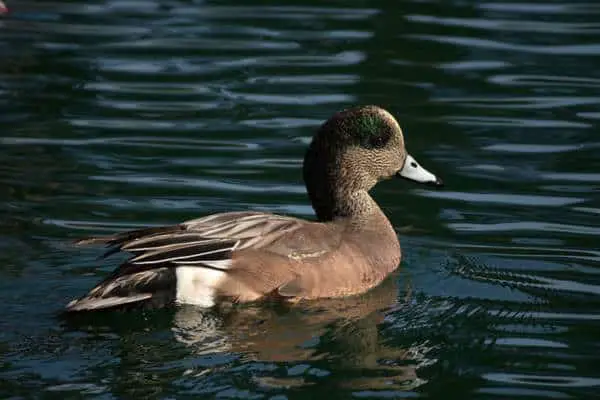
The American Wigeon is a waterbird renowned for its exquisite appearance. The male, or drake, boasts a striking blend of warm browns, creamy whites, and shimmering iridescent greens. Its most distinctive feature is a bold streak of electric blue extending from its eyes to the back of its head.
The female, or hen, displays a more muted but equally beautiful appearance, with mottled brown feathers that provide excellent camouflage. Both genders have a compact and streamlined body, measuring around 18 to 23 inches in length, making the American Wigeon a visually captivating species among the avian kingdom.
Diet
The American Wigeon, with its refined palate, has a diverse and intriguing diet. As a dabbling duck, it is well-versed in the art of foraging for sustenance in wetland environments.
These elegant waterbirds primarily feed on aquatic vegetation, including tender leaves, stems, and seeds of various aquatic plants. They also have a penchant for consuming small invertebrates such as insects, snails, and crustaceans, adding a touch of protein to their menu.
Nesting
The nesting habits of the American Wigeon reveal a captivating tale of dedication and ingenuity. The female constructs a well-camouflaged nest on the ground, often concealed amidst vegetation or grasses, providing a safe haven for the upcoming brood.
Using plant materials such as grass, reeds, and twigs, she skillfully weaves together a sturdy and compact structure. To ensure the nest remains comfortable and insulated, she lines it with soft down feathers, creating a cozy bed for the eggs.
Once the nest is complete, the female lays a clutch of 6 to 12 creamy white or pale olive-colored eggs, each measuring around 2.5 inches in length. She diligently incubates the eggs for approximately 25 to 26 days, carefully regulating the temperature and humidity levels to promote proper development.
During this incubation period, the male stands guard nearby, keeping a watchful eye and providing protection against potential threats. Together, they form a committed and devoted pair, working in harmony to ensure the success of their offspring.
After hatching, the downy young, called ducklings, are led to nearby water sources by the attentive parents, who provide guidance and protection during their early stages of life. The American Wigeon’s nesting journey highlights their adaptability and resilience, showcasing the intricate balance between nature’s design and the nurturing instincts of these remarkable waterbirds.
Behavior

The behavior of the American Wigeon unveils a captivating display of social dynamics and natural prowess. These waterbirds are known for their gregarious nature, often forming large flocks during migration or wintering periods. Within these flocks, they engage in fascinating behaviors that showcase their adaptability and cooperative spirit.
One remarkable behavior of the American Wigeon is their propensity for synchronized feeding. They often swim in unison, creating a mesmerizing sight as they bob their heads beneath the water’s surface in a coordinated manner, foraging for aquatic vegetation and small invertebrates. This synchronized feeding not only enhances their chances of finding food but also strengthens the bond within the flock.
During courtship displays, the drakes showcase their elegant plumage and engage in elaborate rituals to attract females. These displays involve vigorous head-bobbing, wing-flapping, and whistling calls, all aimed at captivating the attention of potential mates.
In flight, the American Wigeon demonstrates agility and grace. Their wings beat swiftly, producing a distinctive whistling sound that echoes through the air. They often fly in V-shaped formations, taking advantage of the aerodynamic benefits and maintaining a sense of unity within the flock.
Habitat
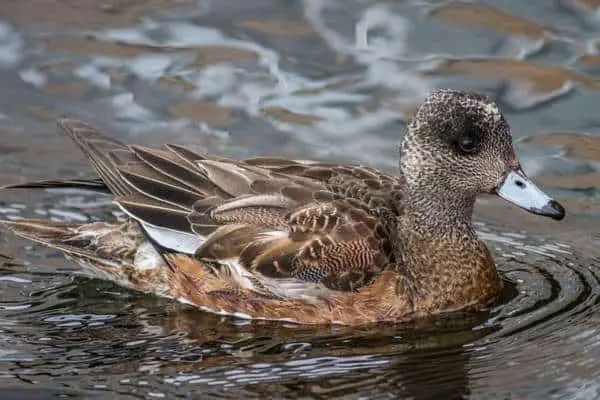
The American Wigeon finds its home amidst a tapestry of captivating wetland habitats. These adaptable birds can be found in a variety of environments across North America. They favor marshes, ponds, and lakes, where they gracefully glide across the water’s surface, their vibrant plumage reflecting in the shimmering ripples.
Range
The American Wigeon is a migratory duck species that can be found in various regions of Hawaii. During the winter months, they migrate to the islands, seeking refuge in wetlands, marshes, ponds, and coastal areas. With their distinctive plumage and characteristic whistling calls, these beautiful ducks grace the Hawaiian landscapes, adding a touch of color and vibrancy to the local birdlife.
Conservation Status
The American Wigeon, fortunately, enjoys a relatively stable conservation status. As of now, it is classified as a species of “Least Concern” by the International Union for Conservation of Nature (IUCN). This categorization reflects the overall healthy population and widespread distribution of the species.
Interesting Facts
1. “Whee-ooo” Calls
The vocalizations of American Wigeons are distinctive and easily recognizable. They emit a whistling call that resembles the sound “whee-ooo,” which is often heard during courtship displays and in flight.
2. Pintail Pretenders
The male American Wigeon is often mistaken for a Northern Pintail due to their similar body shape and long, pointed tails. However, the American Wigeon can be easily distinguished by its unique plumage and distinctive head markings.
3. Fast Flyers
American Wigeons are agile and swift in flight, capable of reaching impressive speeds. They can fly at speeds of up to 55 miles per hour (88 kilometers per hour), allowing them to cover significant distances during their migrations.
4. Dive and Dabble
While American Wigeons primarily engage in dabbling behavior, they are also capable of diving to forage for food. They can briefly submerge themselves to reach submerged vegetation or shallow aquatic prey.
5. Feather Flexibility
The feathers of American Wigeons are highly flexible, which aids in their maneuverability both in the air and in the water. This flexibility allows them to change direction quickly and efficiently while maintaining flight stability.
Frequently Asked Questions
What is the average lifespan of an American Wigeon?
The average lifespan of an American Wigeon is around 10 to 15 years in the wild, although some individuals may live longer.
Can American Wigeons hybridize with other duck species?
Yes, American Wigeons can hybridize with other duck species, including Eurasian Wigeons, Mallards, and Gadwalls. These interbreeding occurrences can result in interesting combinations of physical traits and genetic diversity.
Are American Wigeons territorial?
American Wigeons are not highly territorial compared to some other waterfowl species. While they may defend their immediate nesting area, they often tolerate the presence of other individuals and can be seen foraging and roosting in close proximity to each other.
Are American Wigeons commonly kept in captivity?
American Wigeons are not commonly kept in captivity as domestic waterfowl. They are primarily wild birds and are best appreciated in their natural habitats.
Are American Wigeons aggressive towards humans?
American Wigeons are generally not aggressive towards humans unless they feel threatened or cornered. They tend to be more wary of humans and will usually avoid close contact.
